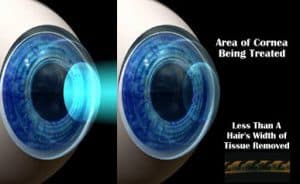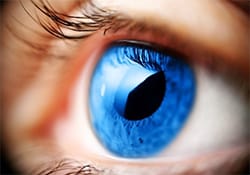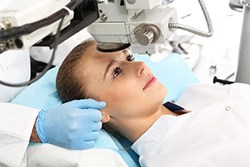Photorefractive Keratectomy (PRK) treats nearsightedness, farsightedness and/or astigmatism to reduce or eliminate dependence on glasses or contact lenses. Like LASIK, PRK uses a laser to reshape the cornea so light can properly focus on the retina for clear vision; unlike LASIK, PRK does not involve the creation of a corneal flap to access the underlying stromal tissue. Instead, the outer layer of cells is completely removed.
Benefits of PRK
- No risk of flap-related complications
- Suitable for patients who do not qualify for LASIK because of thin corneas or because their occupations put them at risk of a corneal complication
- Because a corneal flap is not created, there is more underlying stromal tissue available for treatment
- Lower risk of compromised corneal thickness than with LASIK
The outlook after PRK is the same as LASIK. Once you have recovered, you can expect improved visual acuity without glasses or contact lenses. You should be able to go about most of your daily activities without the need for corrective aids.
According to the Cleveland Clinic, approximately 90 percent of PRK patients have 20/20 vision without corrective eyewear one year after surgery. Over 95 percent have 20/40 or better without visual aids.
What Happens During PRK Eye Surgery?
First, your eye is numbed using an anesthetizing eye drop. Then, Dr. Kornmehl removes the epithelium, a thin layer of protective skin that covers the cornea. This may be done with either a brush or the excimer laser. During the procedure, you will stare at a fixation light. In less than a minute, the laser removes the proper amount of tissue to reshape the surface of the cornea.

After PRK surgery, a bandage lens is placed on the cornea for three to five days. Because the epithelium was removed, you may experience blurry vision for three to five days and a mild to moderate amount of discomfort until the epithelium heals and covers the treated area. Eye drops, and narcotics are effective in reducing this post-operative discomfort. Final visual results may be fully realized anywhere from several days to a few months or more as the surface heals in accordance to your individual healing tendencies.
Am I a Good Candidate for PRK?
You may be a candidate for PRK if you have trouble seeing clearly without glasses or contact lenses. PRK is most often used to treat low to high amounts of nearsightedness, farsightedness and astigmatism. You should be 18 years old and have a steady eye prescription that has not changed within the last year. Your corneas should be healthy, and your overall eye health should be strong. You should have reasonable expectations of what the procedure can and cannot achieve.
You may be better suited to PRK than LASIK if:
- Your corneas are too thin or your corneal surface is too irregular to withstand the creation of a corneal flap.
- You are an athlete or have an active job and are at risk of dislodging the corneal flap after LASIK, causing a complication.
The PRK Consultation
The best way to determine whether you are a good candidate for vision correction with PRK is to meet with Dr. Kornmehl for an in-person consultation. During the appointment, your eyes will be thoroughly examined to look for any problems. Your visual acuity will be tested to determine your refractive error. Your corneal surface will also be measured and mapped to determine whether you are a candidate for PRK or LASIK; if you are, the information will be used to program the laser used during surgery.
Preparing Yourself for PRK
Once you have been deemed a candidate for PRK and have scheduled your surgery, you will need to do a few things to prepare for your operation. Continuing to not wear your contact lenses after your consultation is recommended to ensure the accuracy of the treatment based on the original measurements. If you need to wear your contacts after the consultation, you will be required to discontinue wearing them for the same duration of time as in preparation for your consultation. Soft contact lenses should be discontinued for one week. Soft toric or gas permeable contact lenses should be discontinued for three weeks. A return visit will be required if you need to wear your contact lenses for corneal measurements and mapping to ensure the most accurate information to provide a safe treatment for you.
On the morning of your surgery, you should eat a small meal and take your usual medications as prescribed. Refrain from wearing eye makeup, lotions or creams on your face. If you have any questions about preparing for surgery, contact Dr. Kornmehl’s office.
FAQ’s about PRK

How does PRK differ from LASIK?
The LASIK eye procedure involves creating a thin flap of tissue in the cornea, folding it back and sculpting the underlying tissue with a laser. During PRK, instead of making a flap in the corneal tissue, the top layer of tissue is simply removed. After surgery, it regenerates on its own.
How is PRK performed?
First, the eye is numbed with anesthetic drops. Then, the surface, or epithelial, cells of the cornea are removed with a brush or laser. The underlying corneal tissue is sculpted to improve the refractive error. After surgery, a bandage contact lens is placed over the eye to protect it as it heals.
What is the recovery like after PRK?
Recovering from PRK takes longer than recovering from LASIK because the epithelial tissue has to heal. The bandage contact lens should be worn for five days during the initial healing process. Vision may be blurry as the eye heals, and special eyedrops should be used during recovery. Most patients are 20/40 four days after surgery, but it can take up to 30 days for the patients to see final visual results, up to three months for slower healers.
What are the benefits of PRK?
One of the primary benefits of PRK is that it eliminates the risk of flap-related complications. Although complications are rare after LASIK, they are possible. With PRK, there is no concern about direct trauma to the eye that could dislodge or disturb the cornea.
What are the risks of PRK?
 PRK risks include unpredictable healing of the cornea, complications of scarring, and infection.
PRK risks include unpredictable healing of the cornea, complications of scarring, and infection.
What laser vision correction procedure is right for me?
The best way to determine the procedure that is the safest for you is to meet with Dr. Kornmehl to discuss your options. You may be a candidate for one or both, but you won’t know until you consult with Dr. Kornmehl.
Contact Kornmehl Laser Eye Associates
To schedule a consultation to discuss laser vision correction with Dr. Kornmehl, please call or email our practice today.